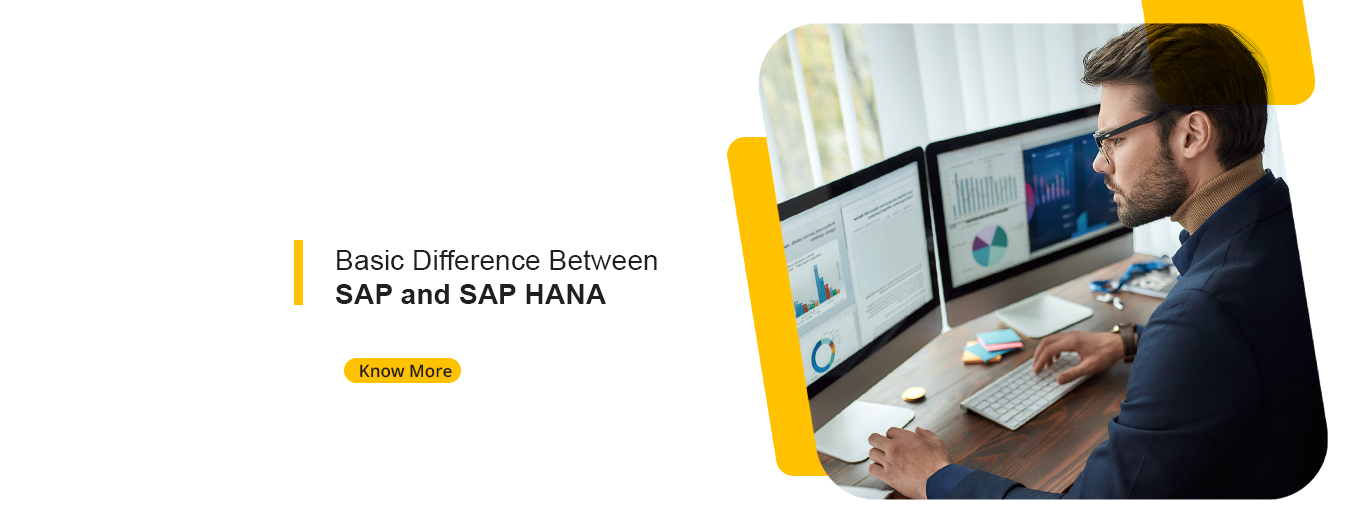Businesses employ software to work more effectively and increase productivity. With so many market options, it can be challenging to decide which will be ideal for your business. Finding the right software requires research, time commitment, and weighing the advantages and downsides.
Did you know that 77% of all transactional revenue in the globe involves a SAP system?
People who wish to boost productivity, make wise judgements and accomplish quick data retrieval and analysis, for instance, can benefit from a wide number of SAP products. The distinction between SAP and SAP HANA has been a topic of discussion among all SAP ERP users. Thus, in this article, we have mentioned how SAP HANA is different from SAP.
What Are The Differences Between SAP & SAP HANA?
SAP stands for Software Application Platform and is a database management system (DBMS). Whereas, SAP HANA is a platform designed specifically for big data analytics applications. One of the main differences between SAP and SAP Hana is that SAP HANA is optimized for real-time analytics, whereas SAP is optimized for batch processing.
Generally speaking, SAP is a software programme that offers a single environment for creating applications that run on several platforms. To assist businesses in creating, deploying, managing, monitoring, and maintaining their business applications, SAP provides a comprehensive collection of tools and services. These apps were created utilising SAP’s integrated suite of technologies, which includes product lifecycle management, supply chain management, customer relationship management, and enterprise resource planning (ERP) (PLM).
Unlike previous databases, SAP HANA is an innovative, high-performance in-memory database that employs a simpler approach. Since SAP HANA stores its data in memory rather than on hard drives as other databases do, it can get the needed data much more quickly. To install services more quickly, maintain systems correctly, and reduce the risk of service failures, users should purchase different business Linux for SAP Hana from a reliable vendor.
For example, if you want to analyze sales data, you would use SAP HANA. If you wanted to run a report on how many customers have purchased something over the last year, then you would use SAP.
With SAP HANA, you may simultaneously access many databases in parallel for both analytical (OLAP) and transactional (OLTP) queries, which is not possible with traditional databases. By being compatible with a variety of database management systems, SAP HANA’s source-agnostic capabilities make it easier to gather data from several external sources and make data integration simple (DBMS).
Final Words
For its application suites, SAP has created its own database called HANA. The idea of In-Memory is the foundation of HANA. Even though both SAP and SAP HANA are excellent tools for effective business operations, these platforms have their own Pros and Cons. However, many businesses believe SAP HANA offers more functionality and is more user-friendly in terms of SAP.
FAQs
What is the full form of SAP HANA?
High-Performance Analytic Appliance is HANA’s full name. The company is commonly known by the name SAP (Software Application Platform).
What are the benefits of SAP?
Some of the excellent benefits of SAP are mentioned below;
- SAP helps businesses to reduce costs and increase efficiency
- SAP helps companies to improve productivity and profitability
- SAP helps companies achieve a competitive advantage
- SAP helps companies gain market share
- SAP helps companies stay ahead of the competition
- SAP helps companies reduce risk and uncertainty
- SAP helps companies become more agile




